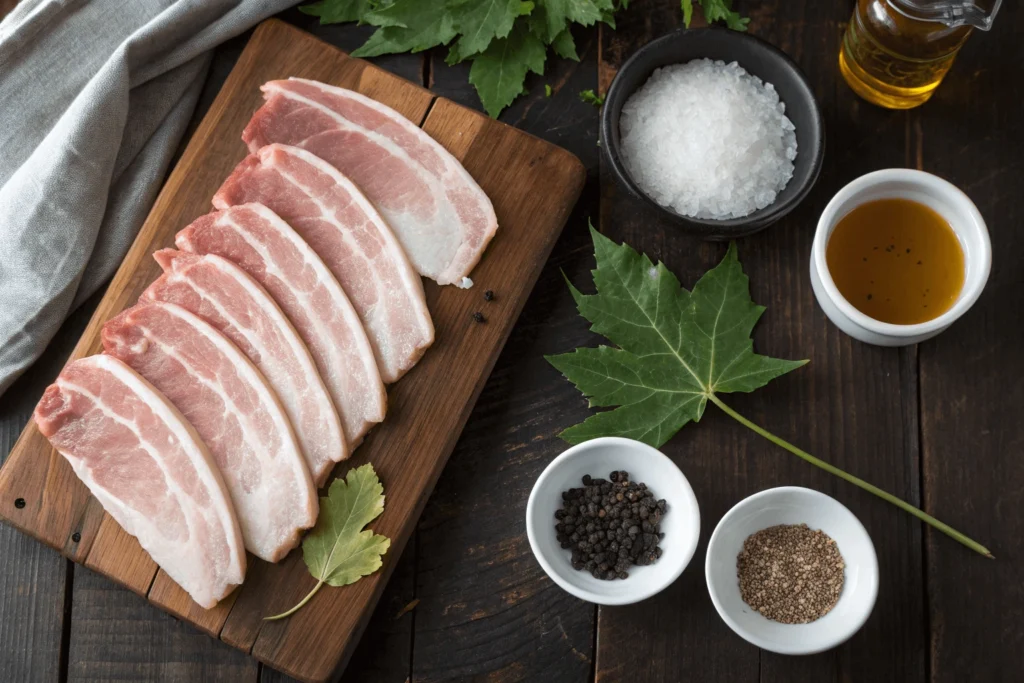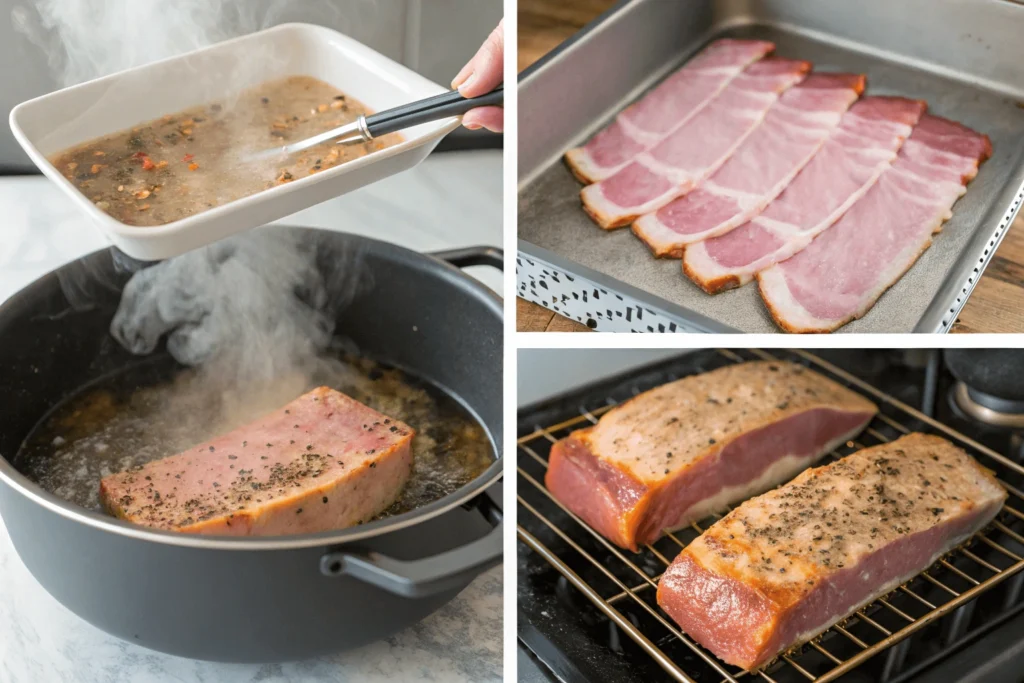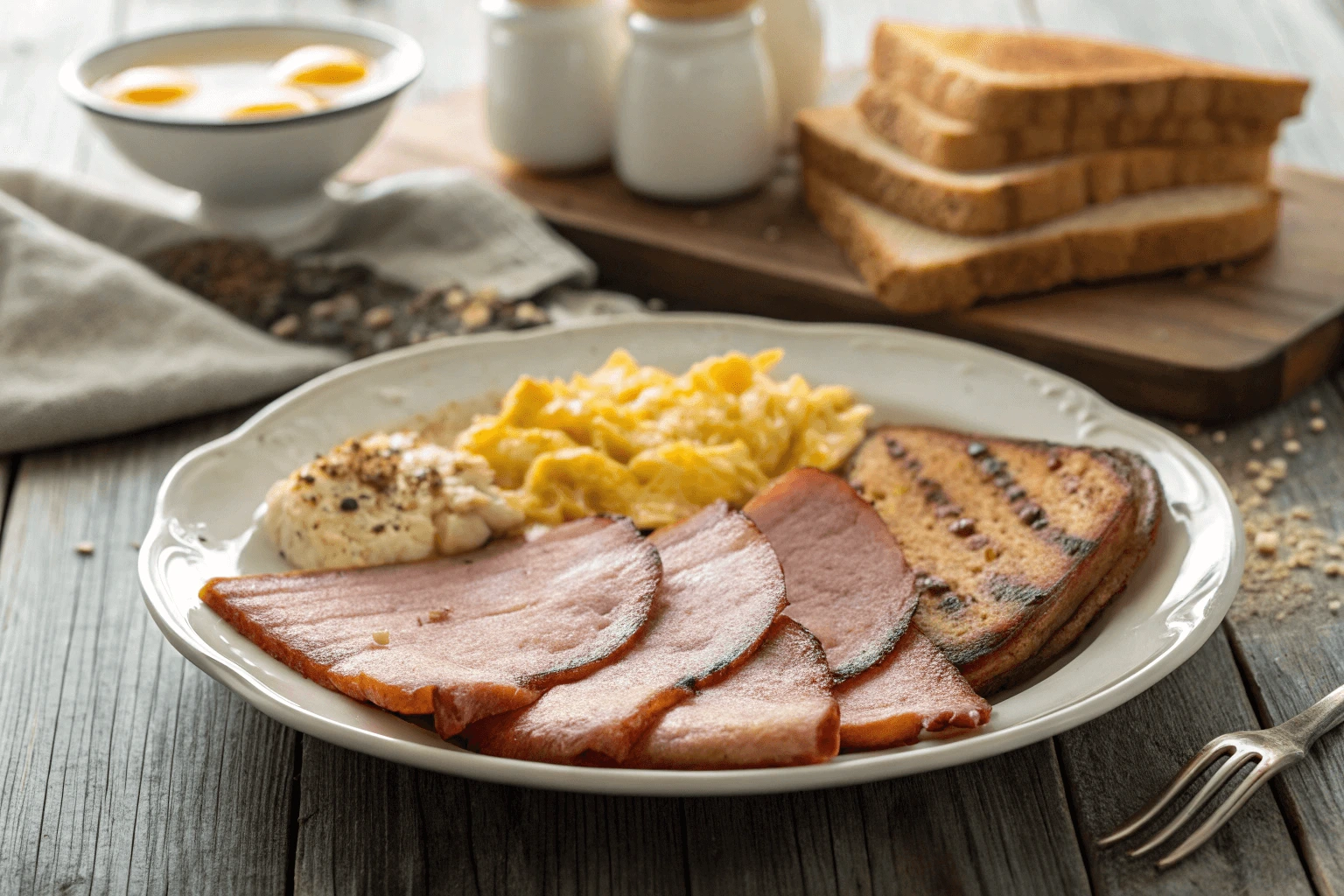Introduction
If you love a hearty breakfast or a tasty sandwich, you’ve probably come across Canadian bacon. Despite its name, it’s not the same as traditional bacon made from pork belly. Instead, it comes from lean pork loin, making it a healthier, meatier alternative.
In this guide, we’ll break down everything you need to know about making a delicious Canadian bacon recipe at home. We’ll cover how it differs from peameal bacon, the essential ingredients, step-by-step instructions, and the best ways to cook and store it. Plus, we’ll clear up common questions, like “What is peameal bacon called in the US?” and “What’s the difference between Canadian bacon and peameal bacon?”
Contents
Contents
What Is Canadian Bacon?
Understanding Canadian Bacon vs. Other Cured Meats
At first glance, Canadian bacon might look like ham, but it’s actually a distinct type of cured meat. Unlike American-style bacon, which comes from fatty pork belly, Canadian bacon is made from lean pork loin. It’s cured, smoked, and sometimes lightly sweetened, giving it a mild, slightly smoky flavor.
Many people confuse Canadian bacon with ham because they have similar textures. However, ham can come from various parts of the pig, while Canadian bacon specifically comes from the loin. Another major difference is the preparation—ham is typically wet-cured and fully cooked, whereas Canadian bacon is cured but often requires further cooking.
Why Canadian Bacon Is Popular in the U.S. and Canada
You’ll find Canadian bacon on breakfast plates across North America, but interestingly, it’s more common in the U.S. than in Canada! In Canada, the more traditional form of back bacon is peameal bacon, which isn’t smoked and has a distinctive cornmeal coating.
This leads to some confusion. Many Americans refer to Canadian bacon as simply “back bacon,” while in Canada, people often associate “back bacon” with the uncooked, cornmeal-crusted version. If you’ve ever wondered, “What is the American version of Canadian bacon?”, the answer is the smoked, round slices often found on eggs Benedict or breakfast sandwiches.
Because Canadian bacon is leaner and high in protein, it’s a great option for those looking for a healthier alternative to regular bacon. It brings the same smoky, salty satisfaction without all the extra fat.
Now that we know what Canadian bacon is, let’s talk about how it compares to peameal bacon, a classic Canadian specialty.
The Difference Between Peameal Bacon and Canadian Bacon
Peameal Bacon: The Classic Ontario Specialty
If you’ve ever been to Canada, especially Ontario, you’ve likely seen peameal bacon on breakfast menus. This traditional favorite is made from pork loin, just like Canadian bacon, but there’s a key difference—it’s not smoked. Instead, it’s wet-cured in a brine solution, then rolled in cornmeal for a signature golden crust.
You might be wondering, “What is the yellow stuff on peameal bacon?” That coating is cornmeal, which was originally dried and ground yellow peas, hence the name “peameal.” It helps lock in moisture and creates a crisp texture when cooked. Unlike smoked bacon, peameal bacon is always cooked fresh, either by frying or roasting.
How American “Canadian Bacon” Differs
Many people ask, “What is peameal bacon called in the US?” The truth is, it’s not as common outside of Canada. In the U.S., when people say Canadian bacon, they usually mean the smoked, round slices commonly used in dishes like eggs Benedict.
So, what’s the difference between Canadian bacon and peameal bacon? The main contrast is in the preparation—Canadian bacon is smoked and often fully cooked, while peameal bacon is fresh, cured, and coated in cornmeal. Both are delicious, but if you’re craving a true Canadian breakfast experience, peameal bacon is the way to go.
Essential Ingredients for the Best Canadian Bacon Recipe
Choosing the Right Pork Cut for Authentic Flavor
A great Canadian bacon recipe starts with the right cut of meat. Traditional Canadian bacon is made from pork loin, which is leaner than pork belly. This gives it a firmer texture and a mild, slightly sweet flavor. When selecting pork loin, look for a piece with minimal fat and a uniform shape to help with even curing.
If you’re making peameal bacon, you’ll also need a fresh, uncured pork loin. Unlike Canadian bacon, which is smoked, peameal bacon is simply brined and coated in cornmeal. This makes it an excellent choice if you prefer a juicier, more tender bite.
Must-Have Spices and Brining Ingredients

For a classic Canadian bacon recipe, you’ll need a brine solution. This helps cure the meat, giving it that signature salty-sweet taste. The key ingredients include:
- Water – Forms the base of the brine
- Kosher salt – Helps preserve and season the meat
- Sugar or maple syrup – Adds a touch of sweetness
- Pink curing salt – Ensures food safety and the right color
- Black pepper, garlic, and bay leaves – For extra flavor
If you’re wondering how to make peameal bacon at home, the process is similar, but instead of smoking, you’ll roll the cured pork loin in cornmeal before cooking. This keeps it tender and gives it a crispy edge when fried.
Step-by-Step Guide to Making Homemade Canadian Bacon
Preparing the Brine for a Perfect Cure

A well-balanced brine is the secret to a flavorful Canadian bacon recipe. It infuses the pork loin with moisture, saltiness, and a touch of sweetness. Here’s how to do it:
- Gather Ingredients: You’ll need water, kosher salt, sugar (or maple syrup), pink curing salt, and spices like black pepper, bay leaves, and garlic.
- Heat the Brine: In a large pot, mix water, salt, and sugar. Stir until dissolved, then let it cool completely.
- Submerge the Pork Loin: Place the pork loin in the brine and refrigerate for 3-5 days. Turn it occasionally to make sure it absorbs the flavors evenly.
- Rinse and Dry: After curing, rinse the pork under cold water to remove excess salt. Pat it dry and let it rest in the fridge uncovered for a few hours.
For those asking, “How to make peameal bacon at home?”, the process is similar, except after curing, the pork loin is rolled in cornmeal instead of being smoked.
Smoking vs. Pan-Frying: Cooking Methods Compared
Once cured, Canadian bacon needs to be cooked. You can either smoke it for an authentic flavor or pan-fry it for a quick meal.
- Smoking: Set your smoker to 200°F and smoke the bacon until it reaches an internal temperature of 145°F.
- Pan-Frying: Slice the cured bacon into rounds and cook in a skillet over medium heat for 2-3 minutes per side.
Smoked Canadian bacon has a rich, deep flavor, while pan-fried versions taste slightly sweeter and milder. Both methods are delicious, so it depends on your preference!

How to Cook and Serve Canadian Bacon
Best Cooking Techniques for Crisp and Juicy Slices
Cooking Canadian bacon is quick and easy, making it a perfect addition to any meal. Whether you prefer it crispy or tender, these methods will get the best results:
- Pan-frying: Heat a small amount of oil in a skillet and cook slices for about 2 minutes per side until golden brown.
- Baking: Arrange slices on a baking sheet and bake at 375°F for 10 minutes, flipping halfway through.
- Grilling: Cook slices over medium heat for 3-4 minutes, turning once.
If you’re making peameal bacon, the cooking time will be slightly longer since it’s fresh rather than smoked. A good tip is to sear it first, then finish it in the oven to keep it juicy.
Delicious Serving Ideas for Breakfast, Lunch, and Dinner
Canadian bacon isn’t just for breakfast! While it’s a staple in dishes like eggs Benedict and breakfast sandwiches, it also works well in other meals:
- Breakfast: Pair it with eggs, toast, or pancakes for a protein-packed start to the day.
- Lunch: Add it to a sandwich with melted cheese, lettuce, and tomato.
- Dinner: Dice it and mix it into pasta, salads, or even homemade pizza.
Classic and Unique Recipes Using Canadian Bacon
Traditional Dishes Featuring Canadian Bacon
A good Canadian bacon recipe can be the star of any meal. It’s well known for its role in classic breakfast dishes, but there are plenty of other ways to enjoy it.
- Eggs Benedict: This famous dish layers Canadian bacon, a poached egg, and creamy hollandaise sauce over an English muffin.
- Breakfast Sandwiches: A toasted bagel or muffin with Canadian bacon, eggs, and cheese makes for a perfect morning bite.
- Omelets and Scrambles: Dice Canadian bacon and mix it into scrambled eggs or an omelet with cheese and veggies.
If you’re wondering, “What is the American version of Canadian bacon?”, it’s often found in these breakfast dishes, where the lean, smoky flavor complements eggs and toast.
Creative Recipes to Try at Home
While Canadian bacon is best known for breakfast, it works well in many other dishes. Try these ideas to mix things up:
- Canadian Bacon Pizza: Swap traditional pepperoni for thin slices of Canadian bacon and pineapple for a twist on Hawaiian pizza.
- Bacon-Wrapped Asparagus: Wrap fresh asparagus spears in Canadian bacon and roast until crispy.
- Pasta Carbonara: Instead of pancetta, use diced Canadian bacon for a lighter yet flavorful version of this classic Italian dish.
- Stuffed Chicken Breast: Fill chicken breasts with Canadian bacon and cheese, then bake until juicy and tender.
For those who prefer peameal bacon, it can also be used in these recipes. Just cook it first, since it’s fresh rather than smoked.
Storage and Preservation Tips
How to Store Fresh and Cooked Canadian Bacon
Whether you’re making Canadian bacon at home or buying it from the store, proper storage keeps it fresh longer. If uncooked, store it in the refrigerator in an airtight container for up to a week. Cooked slices should also be refrigerated, ideally in a sealed bag or wrapped in foil.
If you’ve made a batch of peameal bacon and want to store it, keep it tightly wrapped in the fridge. Since it’s fresh and not smoked, it won’t last as long as Canadian bacon.
Freezing and Reheating Without Losing Flavor
To keep Canadian bacon fresh for months, freezing is the best option. Follow these steps:
- Freeze Uncooked Bacon: Wrap whole cured pork loin in plastic wrap, then place it in a freezer-safe bag. It will last up to three months.
- Freeze Cooked Slices: Arrange slices in a single layer on a baking sheet. Once frozen, transfer them to a freezer bag to prevent sticking.
When reheating, avoid microwaving, as it can make Canadian bacon rubbery. Instead, warm it in a skillet or oven for the best texture.
Health Benefits and Nutritional Information
Nutritional Breakdown of Canadian Bacon
A homemade Canadian bacon recipe isn’t just tasty—it’s also a leaner alternative to traditional bacon. Since it’s made from pork loin rather than fatty pork belly, it contains significantly less fat while still delivering a rich, smoky flavor.
Per 2-ounce serving, Canadian bacon provides:
- Calories: Around 90
- Protein: 12-15 grams
- Fat: 3-4 grams
- Sodium: Varies based on curing process
Compared to regular bacon, Canadian bacon has less fat and fewer calories, making it a great choice for those watching their intake.
Healthier Alternatives and Cooking Modifications
If you’re looking for a lighter version, consider:
- Reducing sodium: Lower the salt in the brine or rinse the cured pork before cooking.
- Using natural sweeteners: Maple syrup or honey instead of processed sugar gives a more balanced sweetness.
- Cooking methods: Baking or grilling Canadian bacon reduces the need for added oils.
For those asking, “What is the American version of Canadian bacon?”, the U.S. version is often pre-cooked and found in breakfast dishes. While convenient, homemade versions allow more control over ingredients, making them a healthier option.
Common Mistakes to Avoid When Making Canadian Bacon
Brining and Curing Errors That Affect Taste
Brining is the foundation of a good Canadian bacon recipe, but small mistakes can impact the final result. Here are a few pitfalls to avoid:
- Skipping curing salt: Regular salt alone won’t prevent bacteria growth or give the signature pink color.
- Not curing long enough: A rushed brining process results in uneven seasoning and texture.
- Improper rinsing: Too much salt left on the meat can make it overly salty when cooked.
If you’re wondering how to make peameal bacon at home, the same rules apply—proper brining is essential for a balanced flavor.
Cooking Mistakes That Can Ruin Texture
Even after curing, the cooking process can make or break the texture. Common errors include:
- Overcooking: Since Canadian bacon is lean, it dries out quickly if cooked too long.
- Using high heat: Gentle heat preserves juiciness while achieving a crisp exterior.
- Skipping resting time: Letting it rest after smoking helps lock in moisture.
For those unfamiliar with peameal bacon, you might ask, “What is the yellow stuff on peameal bacon?” The cornmeal coating creates a crispy crust, but if cooked at too high a temperature, it can burn rather than brown properly.
Frequently Asked Questions (FAQs)
What is peameal bacon called in the US?
In the U.S., peameal bacon doesn’t have a widely recognized name, as it’s not as common. However, some people refer to it as “cornmeal bacon” due to its signature yellow coating. Unlike Canadian bacon, which is smoked, peameal bacon is cured and rolled in cornmeal before cooking.
What is the American version of Canadian bacon?
In the U.S., Canadian bacon usually refers to a cured and smoked pork loin that is sliced into rounds. It’s commonly found in breakfast dishes like eggs Benedict. While similar in name, peameal bacon—which is fresh and coated in cornmeal—is rarely sold under the same name in American grocery stores.
How to make peameal bacon at home?
To make peameal bacon, start with a pork loin, brine it in a salt and sugar solution for 3-5 days, then roll it in cornmeal before cooking. Unlike Canadian bacon, which is often smoked, peameal bacon is cooked fresh by roasting or pan-frying.
What is the yellow stuff on peameal bacon?
The yellow coating on peameal bacon is cornmeal. Originally, dried and ground yellow peas were used, giving it the name “peameal.” This coating locks in moisture and creates a crispy texture when cooked.
What’s the difference between Canadian bacon and peameal bacon?
The main difference is that Canadian bacon is cured, smoked, and often pre-cooked, while peameal bacon is wet-cured and covered in cornmeal but never smoked. Peameal bacon stays juicier and must be fully cooked before eating, whereas Canadian bacon is ready to eat after heating.

How to Make Authentic Canadian Bacon at Home (Easy & Delicious!)
- Total Time: 32 minute
- Yield: About 3–5 days (including brining) 1x
Description
This homemade Canadian bacon recipe delivers a smoky, slightly sweet, and savory flavor that pairs perfectly with eggs, sandwiches, or even pizza. Made from lean pork loin, it’s a healthier alternative to traditional bacon. Follow this step-by-step guide to brine, cure, and cook your own Canadian bacon at home.
Ingredients
For the Brine:
- 4 cups water
- 1/4 cup kosher salt
- 2 tbsp sugar or maple syrup
- 1 tsp pink curing salt (Prague Powder #1)
- 1 tbsp black peppercorns
- 2 bay leaves
- 2 cloves garlic, crushed
For the Bacon:
- 1 pork loin (about 2 lbs)
For Cooking:
- 1 tbsp vegetable oil (if pan-frying)
Instructions
- Prepare the Brine: In a large pot, combine water, salt, sugar, curing salt, peppercorns, bay leaves, and garlic. Heat until the salt dissolves. Let cool completely.
- Brine the Pork: Place the pork loin in a large resealable bag or container. Pour in the cooled brine, ensuring the pork is fully submerged. Refrigerate for 3 to 5 days, flipping it once daily.
- Rinse and Dry: Remove the pork from the brine and rinse it under cold water. Pat dry with paper towels and let it rest uncovered in the fridge for at least 12 hours.
- Cook the Bacon:
- Smoking Method: Preheat a smoker to 200°F (93°C). Smoke the pork loin until it reaches an internal temperature of 145°F (63°C), about 2-3 hours.
- Pan-Frying Method: Slice the cured pork into ¼-inch rounds. Heat oil in a skillet over medium heat and cook slices for 2-3 minutes per side until golden brown.
- Serve and Enjoy: Let the bacon cool slightly before slicing. Use it in breakfast dishes, sandwiches, or salads.
Notes
- If you prefer a traditional peameal bacon texture, skip the smoking step and roll the brined pork loin in cornmeal before cooking.
- Store cooked Canadian bacon in the refrigerator for up to 5 days or freeze for up to 3 months.
- If you don’t have a smoker, you can bake the pork at 200°F (93°C) until it reaches 145°F (63°C).
- Prep Time: 15 minutes
- Cook Time: : 2-3 hours (smoked) or 5 minutes (pan-fried)

